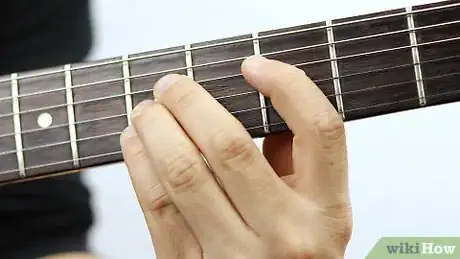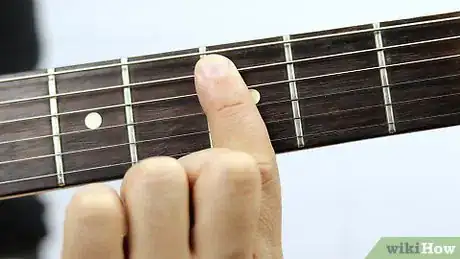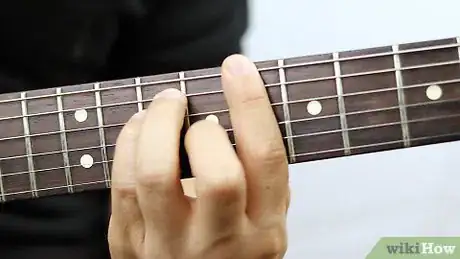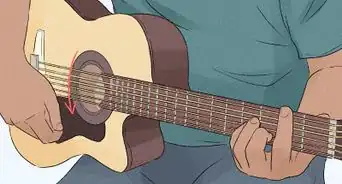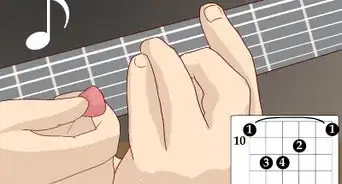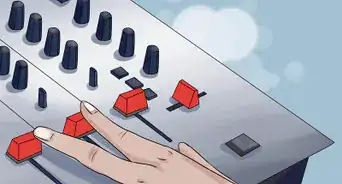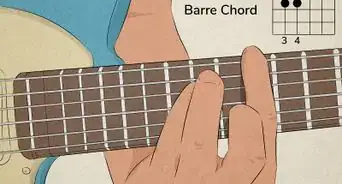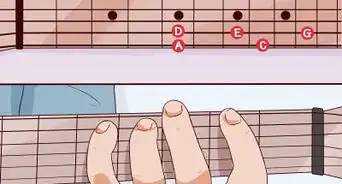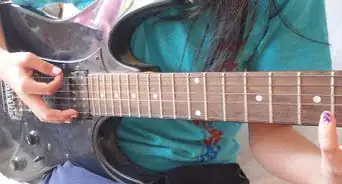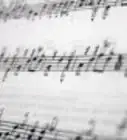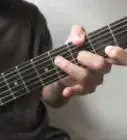This article was co-authored by Nate Savage. Nate Savage is a professional guitarist with over 16 years of experience teaching guitar to students around the world. His YouTube channel, Guitareo, has over 450,000 subscribers.
This article has been viewed 902,033 times.
The C Major chord is one of the most common chords in Western music. Comprised of only 3 notes — C, E, and G — it is one of the first chords most guitarists learn. Once you master the basics of this chord, you can start to learn variants to make your own music!
Steps
Playing an Open C-Major
-
1Review the basics of strings, notes, and frets briefly if you're new to guitar. Knowing how to talk about the guitar will make it much easier to learn your chords. Luckily, numbering on the guitar is easy:[1]
- The strings count from the bottom up, not from the top down. The string closest to the floor while holding the guitar, and the thinnest string, is the 1st string.
- The first fret is the furthest to your left (if you're a right-handed guitarist). The frets are the metal strips in the guitar, and the furthest from your body is the "first fret." The next one closest to you is the second, the next the third, and so on.
- Make sure your guitar is tuned. You can purchase an electric tuner or use an audio guide found on Youtube or Google.
-
2Place your ring finger on the 5th string, 3rd fret. Remember that the 5th string is the second from the top, not the bottom. Your ring finger goes between the 3rd and 2nd fret. This note is a C.[2]
- The closer you push your finger to the 3rd fret, the better your chord will sound.
Advertisement -
3Place your middle finger on the 4th string, 2nd fret. Again, get as close to the fret as you can. Try to use your fingertips to fret as precisely as possible. This is the E note in this chord.[3]
-
4Place your index finger on the 2nd string, 1st fret. This is the high C note for this chord. Now you've reached the chord's final shape, and it looks like a diagonal line pointing away from your head towards the ground.
- The open note between the 2nd and 4th strings is a G.
-
5Strum the bottom five strings. All you need are these three fingers. While it won't be terrible if you accidentally play the top string, the chord will sound much better if you ignore it.
-
6Try the alternate fingerings for a richer open chord. Take your ring finger off the 4th string and drop it to the 6th string, 3rd fret. Then use your pinky to once again fret the 4th string, 3rd fret. This adds another G into the chord for a thicker, richer sound.
-
7Focus on getting your fingers as close to the fret as possible. For the best sounding chords, use the tips of your fingers, placing them as close to the frets as you possibly can. Pick each string individually to see if any of the notes aren't sounding out well, and could use an adjustment.
Playing Alternate Versions of C-Major
-
1Move up to the 3rd fret for a higher-pitched C-major. This variation on the C Major chord starts at the 3rd fret—hence the name "third position."[4] Place your fingers as shown below:
- Place your first finger at the 3rd fret, on the 5th string. Press your finger flat into the neck so that all five strings are held down on the 3rd fret.
- Place your second finger at the 5th fret, on the 4th (D string). This is the G note.
- Place your third finger at the 5th fret, on the 3rd (G string). This is the C note.
- Place your fourth finger at the 5th fret, on the 2nd (B string). This is the high E note.
- When you strum, don't play the bottom or top strings. Just play the middle four.
-
2Use your index finger to bar the third fret for a C-major barre chord. For this version, place your first finger across all the strings at the 3rd fret. Place your other three fingers as described above. This is called a barre chord, or sometimes "bar chord." You lay your index finger flat on the guitar, fretting all five strings on the 3rd fret. Now you can strum the bottom two strings with the others.
-
3Move up to the eighth fret for another C-major barre chord. Will start this next position on the 8th fret. Notice the frets are much closer up here, and the notes sound somewhat higher.
- Place your first finger at the 8th fret across all the strings. Push down so that you've got all the strings barred.
- Place your second finger at the 9th fret of the 3rd string (G string). This note is an E.
- Place your 3rd and 4th fingers at the 10th fret, on the 4th and 5th strings, respectively. Strum all the strings.
Community Q&A
-
QuestionHow can I easily learn to play a guitar?
 Community AnswerThe best way to learn guitar easily is to practice, practice, practice! Take guitar lessons face to face with someone so they can help adjust your fingers and you can see up close how they are playing. However, online lessons can also be effective and cost less.
Community AnswerThe best way to learn guitar easily is to practice, practice, practice! Take guitar lessons face to face with someone so they can help adjust your fingers and you can see up close how they are playing. However, online lessons can also be effective and cost less. -
QuestionHow do I transpose a C chord to others frets (pitches)?
 Community AnswerMove your hand up a fret to go up a half-step. However, you'll have to add a finger to the first fret of any strings that were previously open (or mute them).
Community AnswerMove your hand up a fret to go up a half-step. However, you'll have to add a finger to the first fret of any strings that were previously open (or mute them). -
QuestionWhat is a c chord played by removing the first finger and playing it with an open b string?
 Brandon GiltzCommunity AnswerRemoving the first finger adds a major seventh. On top of a major chord, this turns it into a C major seventh chord.
Brandon GiltzCommunity AnswerRemoving the first finger adds a major seventh. On top of a major chord, this turns it into a C major seventh chord.
Warnings
- Using your bare fingers will hurt; experienced guitar players build up calluses.⧼thumbs_response⧽
- Don't drag the pick too roughly.⧼thumbs_response⧽
Things You'll Need
- An electric or acoustic guitar.
- Pick (optional).
- Fingers
References
- ↑ https://www.guitarlessons.com/guitar-lessons/guitar-lessons-for-beginners/first-guitar-lesson
- ↑ https://nationalguitaracademy.com/guitar-notes/
- ↑ https://takelessons.com/blog/notes-on-a-guitar
- ↑ https://www.guitartricks.com/blog/8-Easy-Steps-for-Changing-Keys
- Videos from GuitarLessons.com
- https://www.youtube.com/watch?v=x1oZ4tdCgbI
About This Article
*Place your index finger on the second string from the bottom, or the B string, at the first fret to play the high C.


